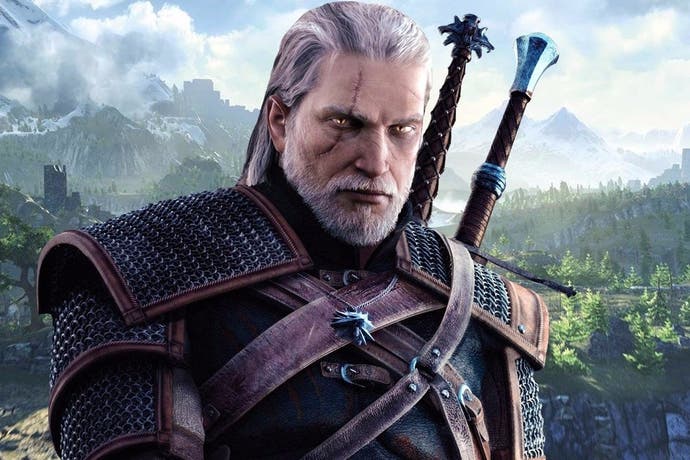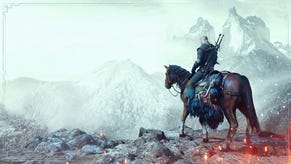Face-Off: The Witcher 3: Wild Hunt
To what extent can PS4 and Xbox One match the fully maxed PC experience?
The Witcher 3 is a game of many firsts. Above all for CD Projekt Red, it has the distinction of launching on three platforms at once, pushing for PC, Xbox One and also its first Sony format - PlayStation 4. Also breaking new ground is a more open-world design than we've seen before in the series, widening the scope of Geralt's adventure as we enter a sprawling third act. We've had a cursory glance at how console versions hold up in performance terms, but factoring in a PC release with plenty of visual bonuses, how do the consoles compare?
Purely in visual terms, PS4 and Xbox One miss out on PC's ultra-grade settings in several areas, but the game still looks complete on each. At its core, REDengine 3 drives a high level of foliage detail on console - perhaps the greatest density of plant-life since the original Crysis, rendering trees in at a surprisingly long range. Factoring in time of day, weather systems and rolling clouds, The Witcher 3's physically-based lighting model also impresses, with shadows spread dynamically from each swaying branch, and light shafts flitting between each leaf. In the right light, the final result helps even the bleakest points in No Man's Land's marshes to achieve a great sense of atmosphere.
This isn't doable without a little help from outside tech. The Umbra 3 plugin in particular is crucial to performance, defining the parameters at which objects become visible, and culling detail intelligently (using a frustum) on PS4 and Xbox One to keep pop-in as discrete as possible. This works with SpeedTree, another middleware engine that handles foliage placement across the world, essentially randomising tuft positions to give the world its distinctive, flourishing look.
With consoles set to patch 1.01 and PC at the latest 1.03, it's fair to say only PS4 can compete with a mainstream gaming PC in terms of pixel-count. Rendering at a native 1920x1080, Sony's platform gives a far crisper looking image at every turn, flattering the game's foliage-heavy details at range. Meanwhile, the promised 'dynamic resolution' solution on Xbox One doesn't appear to hit the 1080p target in any of our samples. Instead, for the most part the game renders at 1600x900, with only video cut-scenes providing true 1080p output for any noticeable length of time.
Alternative comparisons:
Paired with CD Project's custom post-process anti-aliasing mode, edges are at least treated thoroughly. In effect, this gets us a blended half-tone on each stair-step that mimics a 2x MSAA pass, while a temporal component addresses any shimmer on trees in motion. But based on direct image comparisons, it seems Xbox One struggles to reconcile its upscaled resolution with this AA method, and as a result there's a big tail-off in clarity the further into the distance you look. Curiously, PC offers only a single toggle to enable this mode with no alternative, and Nvidia's own control panel settings for MSAA are incompatible with its engine.
PC sets itself apart in several key areas though. With foliage visibility range set to ultra, we get trees, plants and accompanying shadows rendered at a range far beyond anything possible on console. By comparison, PS4 and Xbox One treat each of these variables individually; trees use an equivalent to its medium setting, while foliage is on high, and shadow draw distance is low. It's a hybrid setup that can only be matched on PC by tweaking its .ini file variables manually (found in your documents folder). However, on the console front, both are exactly matched with each other in this area.
This granular approach to optimising for PS4 and Xbox One applies to texture quality too. Here we get a mixture of the PC's medium and high settings, based on which segment of the world you inspect. As a rule of thumb, consoles rarely match PC's best 2024x2024 resolution textures, though low-priority objects with blurrier maps are shared for all three versions. Ground textures in almost every case lack PC's sharpness, and also fall short of its 16x anisotropic filtering. Xbox One gives the worst results here, and in Novigrad City's main plaza, PS4 hits a mid-point in filtering quality between the other two platforms.
Texture filtering is the only difference noted between the console versions. The remainder of the graphics presets are identical, even down to shadow quality and foliage density - both PS4 and Xbox One using the medium setting in each case. This is backed by screen-space ambient occlusion (SSAO) on console, a lower resolution form of the HBAO+ mode offered on PC. With the latter selected, foliage across the ground is clearer and more defined, and less shimmer is visible across shaded areas around geometry. The PC gets a better deal, though both techniques suffer from a visible halo effect around characters passing in front of darkened spots.

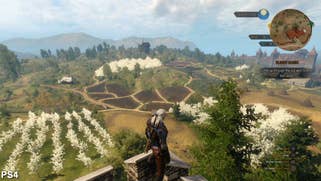
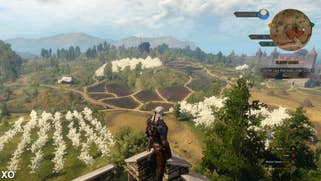



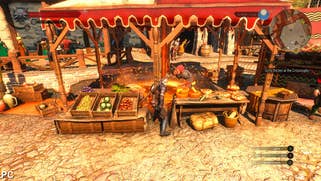


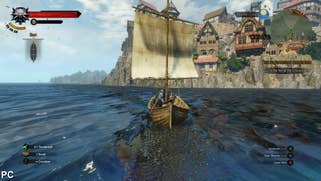


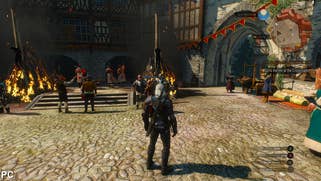

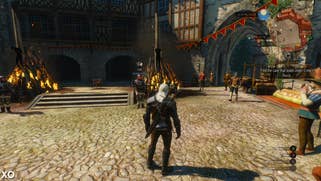





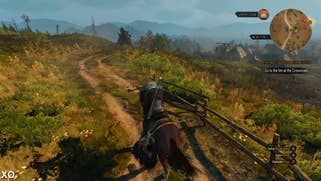

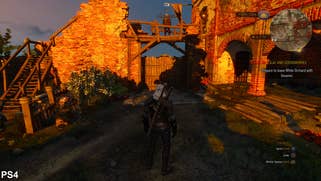

Added to that, physics are greatly improved on the PC release. Water quality is set to high on PS4 and Xbox One, enabling water simulation that has boats rocking with oncoming waves. However the water detail is of a much higher quality on PC, with ripples rendered with a higher precision grade of tessellation. Nevertheless, console users still get a good return here; anything less than the high setting looks very strange indeed, with boats and characters entirely unaffected by the tide.
Nvidia's HairWorks ranks among the more unique additions to the PC release - now in a better optimised state following the latest patch, provided you of course have an Nvidia GPU. PS4 and Xbox One make use of standard, transparency-based hair that bunches strands together while still allowing for simple, physics-based movement. By comparison, thousands of hairs are rendered on the PC's best setting, each of which dynamically interact as Geralt sprints and strikes his sword. Griffin fur, horses' manes and many other elements are affected too - it's a more life-like approach in principle, though for the high performance penalty it's at times hard to notice with the camera drawn as far back as it is. Cut-scenes are mostly where the advance is felt over console, but as impressive as the tech looks in places, the continuous impact to performance - even on high-end GPUs - is too much for all but the most ultra-powerful of rigs.
To round up, all post-processing settings are a match between the three formats, though there are some exceptions. Bloom, light shafts, chromatic aberration, depth of field and velocity-based motion blur are all enabled for PS4 and Xbox One with no cutbacks in quality. As mentioned, the use of SSAO on console is easily the biggest difference in this post-process category, where the cleaner look of HBAO+ is sadly a PC-only feature.
As a bonus, we also have a sharpening filter on PC, which on patch 1.03 gives us low and high options for intensity. Our tests run with this high setting engaged, and the return is mixed; textures and high-contrast details are noticeably crisper at this setting, but aliasing artefacts are intensified across foliage. It's an issue not seen on PS4 or Xbox One, suggesting only a mild form is used there, if any. Footing the list, a vignette filter is also only available to PC users, a simple effect that darkens the corners of the screen if you're that way inclined.
To summarise console performance, PS4 has an advantage in capping its frame-rate at 30fps, while Xbox One daringly keeps things unlocked. Both are v-synced, but the issue for the latter case is that its frame-rate goes between 20-40fps, meaning there's no consistency to when your screen refreshes with a new frame. In theory, this issue is fixable on Xbox One with a patch, as theoretically it rarely dips below the 30fps mark. Sony's platform is our preference right now though, but even here its performance profile isn't exactly ideal. Both drop frames around Novigrad City, suggesting issues with streaming NPC, textures and geometry, while spell effects cause drops below this number during griffin encounters, perhaps more indicative of a GPU bottleneck.
A performance boost is promised, though it's not clear if this is directed at consoles, but the good news is that even those with fairly modest PCs are in line for a great experience. While most of our comparison work was carried out using a Core i7 3770K system with 16GB of RAM and a GTX 780 Ti, we found that applying our learning in terms of console-level quality settings allowed us to get a decent gameplay experience with far more modest hardware. Running through the game using our preferred budget PC set-up, featuring a Core i3 4130 and an Nvidia GTX 750 Ti, we found that we could achieve visual quality and frame-rates equivalent to the PS4 version of the game. Meanwhile, overclocking the GPU consistently took us above the 30fps threshold. Swapping in an R7 260X - an £80 graphics card from AMD - produced nearly identical performance, spoiled only by some intrusive latency spikes (perhaps down to the DX11 driver issue).
Bumping up our spec to a Core i5 processor tested with a GTX 960 and its closest rival - AMD's R9 280 - our console-quality experience hits the desired 1080p60 for much of the duration, though a quick gallop through the streets of Novigrad City sees performance drop to a low of 50fps on Nvidia hardware, and 45fps on the R9 280. We're still looking into PC performance in more depth, but right now, our feeling is that to surpass console-quality visuals and still hit and maintain 60fps, something like a GTX 970 or an R9 290 is required, unless you're happy to explore lower quality presets.
We also have confirmed reports of The Witcher 3 causing issues for those who overclock their graphics hardware. We were fine with our +200MHz core/+400MHz memory overclock to the reference GTX 750 Ti (we didn't even need to raise its power level), but then again, we were running with console-level quality levels - a mixture of medium and high quality presets. Feedback suggests that really pushing the game taxes a GPU in ways quite unlike any other PC release to date, so be prepared to compromise if you have tweaked, tuned and overclocked your graphics card to its limits.
Alternative analysis:
The Witcher 3: Wild Hunt - the Digital Foundry verdict
Overall, CD Projekt Red's legacy as a developer is deeply entrenched in PC, and to a great extent it shows in this version's extras. Everything from hair physics to broader draw distances make it a cut above console - a sharper, richer-looking release that also benefits from superior textures and effects. The ability to hit and hold 60fps is, to our minds, the PC's best advantage though. Even with its camera stutters, combat is far more responsive than the console's circa-30fps, and on limited GPUs we'd gladly give up the above visual extras up for it.
That said, Geralt's latest chapter is still very approachable on consoles. It's a visuals-over-performance setup that means both PS4 and Xbox One get a density to world detail that's rarely seen on console. And outside of the resolution divide (favouring Sony's platform at a true 1920x1080) core graphics settings are matched between the two, mostly borrowing from PC's medium and high presets. Performance is also a sticking point; PS4 is preferable in this case for its 30fps cap, though it suffers from some stutter, while Xbox One's uncapped frame-rate gives us far less consistent experience. We're still hoping for that optional 30fps cap option on the Microsoft platform.
Having played all three versions extensively this week, it must be said PC is a must for its extras, as well as for its solid, multi-threaded optimisation across all setups tested. On the console front, as of update 1.01 the PS4 version is king thanks to a cleaner 1080p image and slightly smoother frame-pacing - though we hope its hitches are addressed soon in a patch. In launching across three platforms at once The Witcher 3 is a highly ambitious objective for the developer, but CD Projekt Red proves here that it has the mettle for current-gen development - whether it returns us to Novigrad next time, or takes us somewhere entirely new.
